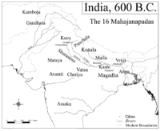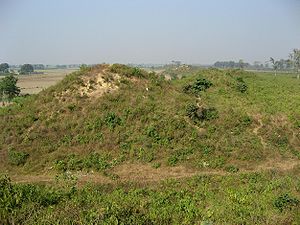
Kosala
Encyclopedia

India
India , officially the Republic of India , is a country in South Asia. It is the seventh-largest country by geographical area, the second-most populous country with over 1.2 billion people, and the most populous democracy in the world...
n region, corresponding roughly in area with the region of Awadh
Awadh
Awadh , also known in various British historical texts as Oudh or Oude derived from Ayodhya, is a region in the centre of the modern Indian state of Uttar Pradesh, which was before independence known as the United Provinces of Agra and Oudh...
in present day Uttar Pradesh
Uttar Pradesh
Uttar Pradesh abbreviation U.P. , is a state located in the northern part of India. With a population of over 200 million people, it is India's most populous state, as well as the world's most populous sub-national entity...
. According to the Buddhist text Anguttara Nikaya
Anguttara Nikaya
The Anguttara Nikaya is a Buddhist scripture, the fourth of the five nikayas, or collections, in the Sutta Pitaka, which is one of the "three baskets" that comprise the Pali Tipitaka of Theravada Buddhism...
and the Jaina text, the Bhagavati Sutra
Vyakhyaprajnapti
Vyākhyāprajñapti commonly known as Bhagavati sūtra is the fifth of the 12 Jain āagam said to be promulgated by Bhagwan Mahavara. Vyākhyāprajñapti translated as "Exposition of Explanations" is said to have been composed by Sudharma Swami Gandhara as per the Svethambara tradition. It is the largest...
, Kosala was one of the Solasa (sixteen) Mahajanapadas
Mahajanapadas
Mahājanapadas , literally "great realms", were ancient Indian kingdoms or countries...
(powerful realms) in 6th century BCE and its cultural and political strength earned it the status of great power
Great power
A great power is a nation or state that has the ability to exert its influence on a global scale. Great powers characteristically possess military and economic strength and diplomatic and cultural influence which may cause small powers to consider the opinions of great powers before taking actions...
. However, it was later weakened by a series of wars with the neighbouring kingdom of Magadha
Magadha
Magadha formed one of the sixteen Mahājanapadas or kingdoms in ancient India. The core of the kingdom was the area of Bihar south of the Ganga; its first capital was Rajagriha then Pataliputra...
and, in the 4th century BCE, was finally absorbed by it. The Kosala region had three major cities, Ayodhya, Saket
Saket
In Sanskrit, Saket means a place close to Heaven, thus a place where God resides. Saket was the ancient name of the city of Ayodhya, an important Hindu religious place, said to be the birthplace of Lord Rama...
and Shravasti
Shravasti
Shravasti can refer to:* Sravasti , an ancient city of India. Its ruins are located in Shravasti District* Shravasti District, Uttar Pradesh, India...
and a number of minor towns as Setavya, Ukattha, Dandakappa, Nalakapana and Pankadha. According to the Puranas
Puranas
The Puranas are a genre of important Hindu, Jain and Buddhist religious texts, notably consisting of narratives of the history of the universe from creation to destruction, genealogies of kings, heroes, sages, and demigods, and descriptions of Hindu cosmology, philosophy, and geography.Puranas...
, Ayodhya was the capital of Kosala during the reign of Ikshvaku
Ikshvaku
Ikshvaku pāli: Okkāka) was the first king of the Ikshvaku dynasty and founder of the Solar Dynasty of Kshatriyas in Vedic civilization in ancient India.-In Hinduism:He is remembered in Hindu scriptures as a righteous and glorious king...
and his descendants. Shravasti was the capital of Kosala between 6th century BCE and 6th century CE.
The Kosala kingdom

In the Ramayana
Ramayana
The Ramayana is an ancient Sanskrit epic. It is ascribed to the Hindu sage Valmiki and forms an important part of the Hindu canon , considered to be itihāsa. The Ramayana is one of the two great epics of India and Nepal, the other being the Mahabharata...
, Mahabharata
Mahabharata
The Mahabharata is one of the two major Sanskrit epics of ancient India and Nepal, the other being the Ramayana. The epic is part of itihasa....
and the Puranas
Puranas
The Puranas are a genre of important Hindu, Jain and Buddhist religious texts, notably consisting of narratives of the history of the universe from creation to destruction, genealogies of kings, heroes, sages, and demigods, and descriptions of Hindu cosmology, philosophy, and geography.Puranas...
the ruling family of the Kosala kingdom was descended from king Ikshvaku
Ikshvaku
Ikshvaku pāli: Okkāka) was the first king of the Ikshvaku dynasty and founder of the Solar Dynasty of Kshatriyas in Vedic civilization in ancient India.-In Hinduism:He is remembered in Hindu scriptures as a righteous and glorious king...
. The Puranas give lists of kings of the Aikhsvaka dynasty
Ikshvaku dynasty
The Ikshvaku dynasty, in Puranic literature, was a mythical dynasty founded by Ikshvaku, grandson of Vivasvan or Surya and son of Vaivasvata Manu. This dynasty is also known as . The important personalities belonging to this royal house are Harishchandra, Dilīpa, Sagara, Raghu, Rama and Prasenajit...
(the dynasty founded by Ikshvaku) from Ikshvaku to Presenajit (Pasenadi). A Buddhist text, the Majjhima Nikaya mentions Buddha
Gautama Buddha
Siddhārtha Gautama was a spiritual teacher from the Indian subcontinent, on whose teachings Buddhism was founded. In most Buddhist traditions, he is regarded as the Supreme Buddha Siddhārtha Gautama (Sanskrit: सिद्धार्थ गौतम; Pali: Siddhattha Gotama) was a spiritual teacher from the Indian...
as a Kosalan and Mahavira
Mahavira
Mahāvīra is the name most commonly used to refer to the Indian sage Vardhamāna who established what are today considered to be the central tenets of Jainism. According to Jain tradition, he was the 24th and the last Tirthankara. In Tamil, he is referred to as Arukaṉ or Arukadevan...
, the 24th Tirthankara of Jainism
Jainism
Jainism is an Indian religion that prescribes a path of non-violence towards all living beings. Its philosophy and practice emphasize the necessity of self-effort to move the soul towards divine consciousness and liberation. Any soul that has conquered its own inner enemies and achieved the state...
taught in Kosala. In the time of king Mahakosala, Kashi
Varanasi
-Etymology:The name Varanasi has its origin possibly from the names of the two rivers Varuna and Assi, for the old city lies in the north shores of the Ganga bounded by its two tributaries, the Varuna and the Asi, with the Ganges being to its south...
was an integral part of the kingdom.. Mahakosala was succeeded by his son Pasenadi
Pasenadi
Pasenadi was a dynasty ruler of Kosala. He succeeded his father . He was a prominent of Gautama Buddha, who built many Buddhist monasteries.-Life:...
(Prasenajit). He was a follower of Buddha. During his absence from the capital, his minister Digha Charayana raised his son Vidudabha to the throne.. Kosala kingdom was absorbed not much later into Magadha kingdom.
Kosala under Mauryan rule
It is assumed that during the Mauryan reign, Kosala was administratively under the viceroy at Kaushambi. The Sohgaura copper plate inscription, probably issued during the reign of Chandragupta MauryaChandragupta Maurya
Chandragupta Maurya , was the founder of the Maurya Empire. Chandragupta succeeded in conquering most of the Indian subcontinent. Chandragupta is considered the first unifier of India and its first genuine emperor...
deals with a famine in Shravasti and the relief measures to be adopted by the officials. The Yuga Purana
Yuga Purana
The Yuga Purana is an ancient Indian text, part of the larger Puranic literature. It is considered as one of the oldest Purana, written around 250 CE. The Yuga Purana consists two chapters, within the larger text of the Gargi Samhita, also called Vriddha Gargiya Jyotisha...
section of the Gargi Samhita mentions about the Yavana (Indo-Greek) invasion and subsequent occupation of Saket during the reign of the last Maurya ruler Brihadratha.
Kosala in Post-Mauryan period
The names of a number of rulers of Kosala of the post-Maurya period are known from the square copper coins issued by them. The rulers are: Muladeva, Vayudeva, Vishakhadeva, Dhanadeva, Naradatta, Jyesthadatta and Shivadatta. There is no way to know whether king Muladeva of the coins is identifiable with Muladeva, murderer of the Sunga ruler VasumitraVasumitra
Vasumitra , was the fourth King of the Sunga Dynasty of Northern India...
or not (though a historian, Jagannath has tried to do so). King Dhanadeva of the coins is identified with king Dhanadeva (1st century BCE) of Ayodhya inscription. In this Sanskrit inscription, King Kaushikiputra Dhanadeva mentions about setting a ketana (flag-staff) in memory of his father, Phalgudeva. In this inscription he claimed himself as the sixth in descent from Pusyamitra Sunga
Pusyamitra Sunga
Pusyamitra Sunga was the founder and first King of the Sunga Dynasty in Northern India.Pusyamitra Sunga was originally a Senapati of the Mauryan empire. In 185 BCE he assassinated the last Mauryan Emperor during an army review, and proclaimed himself King...
. Dhanadeva issued both cast and die-struck coins and both the types have a bull on obverse.

